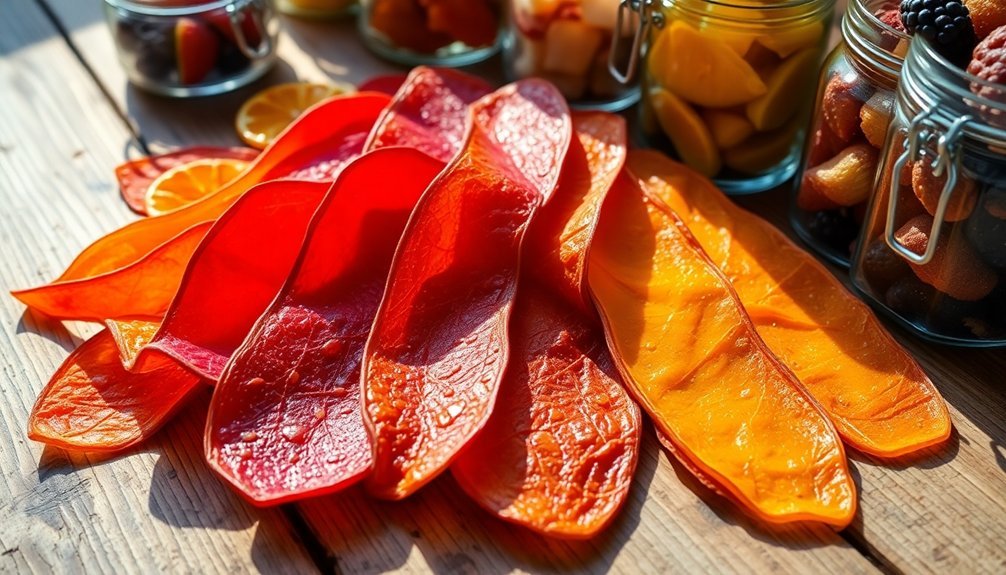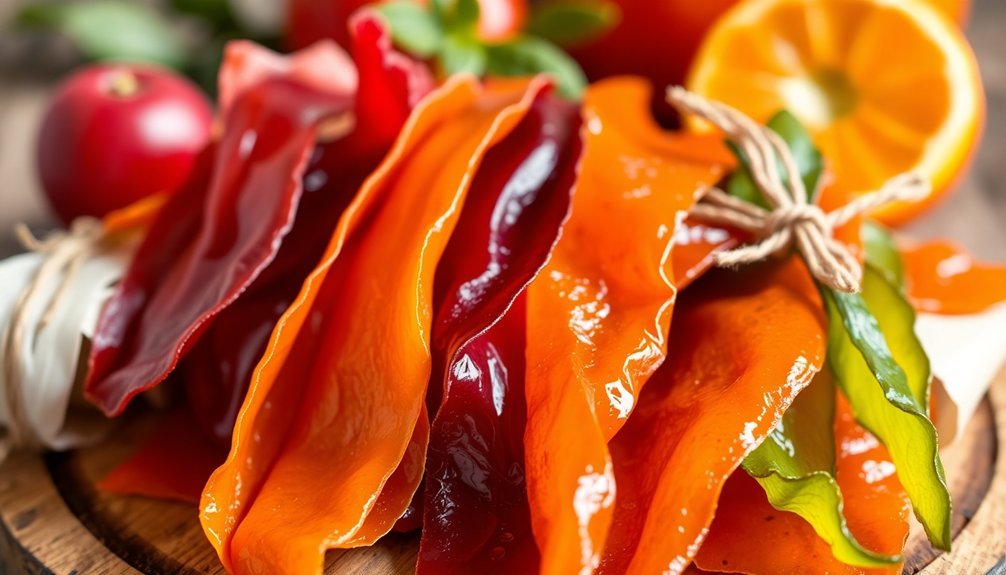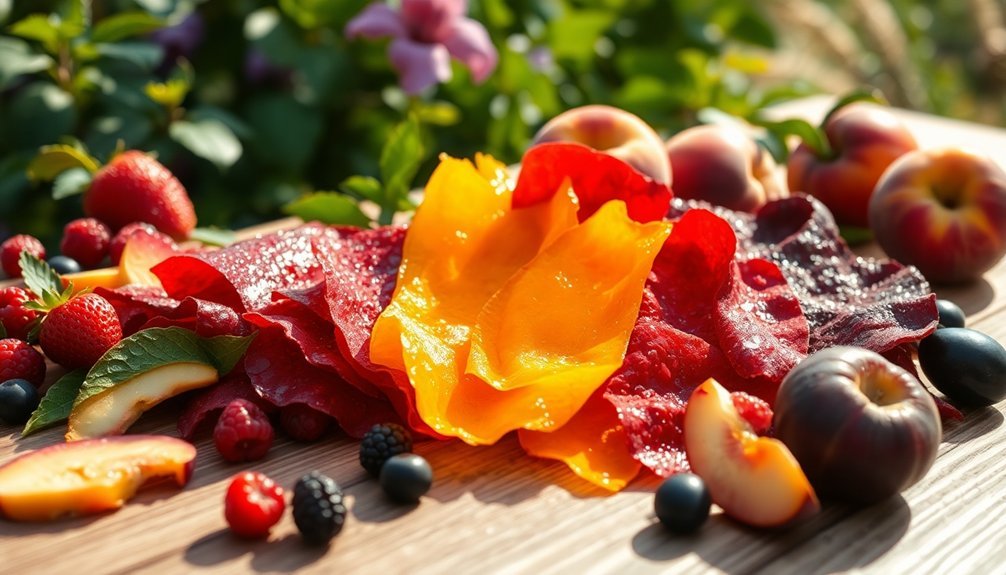If you want to preserve fresh fruits uniquely, air-dried fruit leather is perfect. Start by using ripe fruit, pureeing it, and then drying at a consistent 140°F for several hours. Keep humidity below 60% and guarantee good air circulation by opening your oven door slightly. After drying, store your leather in airtight containers to keep it fresh for up to six months. You can even refrigerate or freeze it for longer shelf life. Regularly check for spoilage signs like mold or off-odors. For more tips on mastering this delicious preservation method, there's plenty more to explore!
Traditional Drying Techniques

When it comes to making air-dried fruit leather, traditional drying techniques play an essential role. You can choose to use either a dehydrator or an oven, both of which have their own advantages.
If you opt for a dehydrator, set it to a steady temperature of 140°F to 145°F and plan on drying your leather for 6 to 10 hours. Make sure to line the trays with specially designed plastic sheets or plastic wrap to avoid sticking. Preheating the dehydrator to 140°F before starting ensures optimal results.
On the other hand, if you prefer using an oven, keep the door open 2 to 6 inches and maintain the same temperature range. A lined 13" X 15" baking pan works best, but avoid materials like waxed paper or aluminum foil.
Drying in the oven can take 4 to 10 hours, so monitor your oven temperature closely to prevent overheating.
Regardless of your method, testing for dryness is essential. Touch the center of the leather; it should feel slightly tacky but not moist. Properly dried leather will peel easily from the pan, ensuring you get that perfect, chewy texture.
Ideal Drying Conditions
To achieve the perfect fruit leather, you need to control the drying conditions carefully. Keeping the temperature at 140°F prevents issues like case hardening, which can trap moisture and lead to mold. Additionally, managing humidity and air circulation is essential; low humidity helps moisture escape while good air flow speeds up the drying process. Using a food dehydrator allows for optimal drying temperature and consistent results, making it an excellent choice for making fruit leather.
Temperature Control Importance
Maintaining the right temperature is essential for successfully drying fruit leather. The optimum temperature for drying is 140°F. If temperatures exceed this, you risk case hardening, where the outer layer dries too fast, trapping moisture inside. This can lead to mold growth during storage, ruining your hard work.
By keeping the temperature stable at 140°F, you guarantee even drying without cooking the fruit leather. This is particularly important because the drying process concentrates sugars, acids, vitamins, and minerals, enhancing the overall quality of the final product.
Using a dehydrator is one of the best methods, as they typically maintain a temperature of 135-140°F for 6-8 hours. If you opt for an oven, make certain it can hold that low temperature—sometimes, you may need to leave the door slightly ajar to achieve it.
Convection ovens with fans can further enhance air circulation, improving drying efficiency.
Regularly check the temperature with an oven thermometer to prevent case hardening and make certain your fruit leather remains pliable. Proper temperature control not only affects texture but also preserves the nutritional and flavor qualities of the fruit.
Stick to the recommended temperature, and you'll enjoy high-quality fruit leather every time.
Humidity Impact on Drying
Humidity plays a significant role in the drying process of fruit leather. High humidity can seriously slow down your drying efforts, making it essential to aim for conditions below 60%. If it's a rainy day, you might want to postpone your drying session, as humid weather creates a barrier for moisture to escape from the fruit leather.
In contrast, low humidity helps the drying process by allowing moisture to evaporate into the surrounding air.
To enhance drying efficiency, guarantee good air circulation around your fruit leather. You can do this by propping the oven door open a bit or using a fan near the oven to keep that moist air moving away. This airflow is especially important in dehydrators and convection ovens, as it prevents moisture from getting trapped inside.
If you're considering sun drying, remember that hot, dry, and breezy days are ideal. However, be cautious of unpredictable weather.
Regardless of your drying method, guarantee that once your fruit leather is fully dried, it's stored in clean, moisture-resistant containers to maintain its quality and prevent spoilage.
Effective Storage Practices

Proper storage practices are essential for keeping your air-dried fruit leather fresh and flavorful. To guarantee your fruit leather stays in prime condition, use airtight containers or zip-top bags to protect it from air and moisture. Wrap individual pieces in parchment paper or plastic wrap before placing them in containers. For ideal organization, roll your fruit leather and cut it into small, single-serve pieces.
Here's a quick reference table for effective storage:
| Storage Method | Tips |
|---|---|
| Airtight Containers | Use to prevent air and moisture exposure |
| Vacuum-Sealing | Removes air for a tight seal |
| Refrigeration | Prevents stickiness in humid conditions |
| Freezing | Extends shelf life up to 1 year |
| Cool, Dry Place | Keep between 60°F to 70°F (15°C to 21°C) |
Always handle your fruit leather with clean, dry hands to avoid introducing moisture. Check periodically for spoilage signs and thaw frozen pieces in the refrigerator to prevent condensation. By following these practices, you'll keep your homemade fruit leather delicious and ready for snacking!
Understanding Shelf Life
Understanding the shelf life of air-dried fruit leather is essential for enjoying its best flavor and texture. Several factors influence how long your fruit leather lasts. If you make it at home, expect a shelf life of just 1-2 months without preservatives.
Store-bought varieties, on the other hand, can last 3-6 months due to added preservatives that enhance longevity. Natural ingredients, like fruit purees and sugar, also contribute to preservation, especially when using acidic fruits that have natural durability.
For longer storage, consider refrigeration, which can extend the life of both homemade and store-bought fruit leather to about 6 months. Keeping it in an airtight container helps maintain quality and prevent mold growth.
When checking for spoilage, look for signs like mold, off-odors, or changes in texture. Darkening color may indicate degradation, while a loss of flavor or excessive dryness can signal that it's time to toss it out.
Proper Packaging Methods

When it comes to packaging your air-dried fruit leather, choosing the right airtight container is crucial for maintaining freshness.
You'll want to layer your fruit leather properly to prevent sticking and guarantee even storage.
Let's explore some effective options and techniques to keep your delicious snacks safe and tasty.
Airtight Container Options
To keep your air-dried fruit leather fresh and flavorful, storing it in airtight containers is essential. You have several options for packaging your fruit leather effectively. Airtight containers, whether plastic or glass, are ideal for preventing moisture absorption, which can lead to spoilage.
If you're using plastic bags, make sure to squeeze out as much air as possible before sealing to maintain freshness. Glass containers with tight-fitting lids are also a great choice. They not only keep your fruit leather safe from moisture but also provide a clear view of your delicious treat.
While paper bags can work, be cautious; they shouldn't be too airtight to avoid moisture buildup. For added protection, consider wrapping your fruit leather in plastic wrap or parchment paper before placing it in your chosen container. This helps prevent sticking and further shields it from moisture.
Always store your containers in a cool, dry, dark place to maximize preservation. By following these guidelines, you can enjoy your homemade fruit leather at its best for weeks or even months!
Layer Separation Techniques
Proper packaging methods are essential for maintaining the quality of your air-dried fruit leather and preventing layer separation. To guarantee your fruit leather stays fresh and intact, follow these steps:
- Roll and Wrap: Roll the fruit leather tightly to prevent moisture from entering. Use plastic wrap, waxed paper, or parchment paper for wrapping.
- Cool Down: Let the leather cool for 1-2 hours before you handle it. This helps finish the drying process and softens any crisp edges.
- Storage: Store your wrapped rolls or cut strips in a cool, dry, dark place. Make sure the container is slightly open until the leather is completely dry.
- Check Regularly: Periodically check your stored leather for signs of mold or deterioration, and discard any affected pieces.
Ensuring Safety and Quality
Ensuring the safety and quality of your air-dried fruit leather is essential for a delicious and healthy snack. Start by selecting ripe or slightly overripe fruit, washing it in cool water, and removing any peels, seeds, and stems. Cut the fruit into chunks and puree it until smooth, using about 2 cups of fruit for each 13" x 15" inch batch.
To prevent discoloration and spoilage, add 2 teaspoons of lemon juice or 1/8 teaspoon of ascorbic acid for every 2 cups of light-colored fruit. These ingredients help maintain color and reduce bacterial growth. You can also mix fruit purees, like strawberries with applesauce, to aid in quicker drying.
When drying, maintain a temperature of 140°F to avoid case hardening. Use a dehydrator, oven, or sun, ensuring moisture escapes by keeping the oven door slightly ajar. After drying, test for doneness by touching the center; it shouldn't show any indentation.
Store your fruit leather in airtight containers, and use plastic wrap between layers to prevent sticking. Properly stored, it lasts up to a month at room temperature or up to a year in the freezer.
Frequently Asked Questions
Can I Use Frozen Fruit for Making Fruit Leather?
Yes, you can use frozen fruit to make fruit leather! Just thaw the fruit, puree it until smooth, and then dry it in an oven or dehydrator for a delicious, chewy snack. Enjoy!
What Fruits Work Best for Air-Dried Fruit Leather?
For air-dried fruit leather, choose berries, stone fruits, and apples. Look for peak ripeness and high pectin content to enhance flavor and texture. Mixing fruits can also improve drying efficiency and taste.
How Can I Enhance the Flavor of My Fruit Leather?
To enhance the flavor of your fruit leather, try combining ripe fruits, adding sweeteners like honey, and incorporating spices such as cinnamon or ginger. Experiment with different combinations to discover unique and delicious flavors you'll love!
Is It Safe to Dry Fruit Leather in High Humidity?
It's not safe to dry fruit leather in high humidity. Moist air slows drying, leading to incomplete moisture removal, stickiness, and increased mold risk. Aim for low humidity to guarantee safety and quality in your fruit leather.
Can I Combine Different Fruits in One Leather Batch?
Yes, you can combine different fruits in one leather batch! Just mix high-water fruits with drier ones for balance, and consider adding high-pectin fruits for a smoother texture. Experiment to find your favorite flavor combinations!
In Summary
To sum up, air-drying fruit leather is a rewarding way to preserve nature's bounty. By using traditional drying techniques and ensuring ideal conditions, you can create delicious snacks that last. Remember to store your fruit leather properly and keep an eye on its shelf life. With the right packaging methods, you'll maintain both safety and quality. So go ahead, embrace this time-tested method, and enjoy your homemade treats with confidence!





Leave a Reply